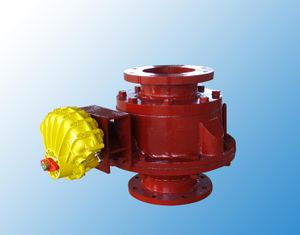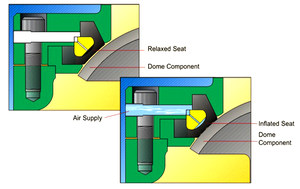Difference between revisions of "Dome Valves"
(Created page with "Category:Valves{{Knoppen}} <noinclude><!------------------------------------------------ * READ THIS FIRST * Only edit this page if you can improve the content. * Improper u...") |
|||
| (2 intermediate revisions by the same user not shown) | |||
| Line 1: | Line 1: | ||
[[Category:Valves]]{{Knoppen}} | [[Category:Valves]]{{Knoppen}} | ||
[[File:Dome Valve.jpg|thumb|right|Dome Valves]] | |||
[[File:Dome valve1.png|thumb|right|Dome Valves]] | |||
'''Dome Valve''' is a pressure tight compressed air operated valve, capable of returning over one million maintenance-free cycles, even in abrasive, hazardous or toxic applications.It is unique in its ability to open and close with a tight pressure seal in environment where abrasive materials are passing. | |||
* | |||
* | |||
==Principle Of Operation== | |||
The Dome component closes beneath the seat(seal) when the seal is relaxed (not inflated), allowing a controlled gap between the seat (seal) and the closing member (Dome). Material is allowed to pass through or enter the controlled gap if, due to its characteristics, it is pulled into the gap by the action of the Dome component moving to its closed position. In the closed position, high pressure air or other gas enters the space between the back of the seal face and the insert ring to cause the seal face to expand onto and around the periphery of the Dome component. Material particles are entrapped by the seal against the dome surface, irrespective of particle size or shape. Before opening the valve, the seat is relaxed, and the controlled gap is reestablished before the Dome component moves to its open position. The seal is a loose component clamped into place by a spigot piece and external fasteners holding the top plate assembly to the body. The seal is easily removed for inspection. | |||
==Features== | |||
* Full bore material flow | |||
* Only a quarter turn from fully closed to fully open | |||
* Can cut through column of static material | |||
* Copes with materials up to 480 deg C | |||
* Sealing pressures up to 30 barg | |||
* Handles abrasive products with ease | |||
* No moving wear parts | |||
* Long intervals between maintenance visits | |||
Latest revision as of 03:18, 12 January 2013
Dome Valve is a pressure tight compressed air operated valve, capable of returning over one million maintenance-free cycles, even in abrasive, hazardous or toxic applications.It is unique in its ability to open and close with a tight pressure seal in environment where abrasive materials are passing.
Principle Of Operation
The Dome component closes beneath the seat(seal) when the seal is relaxed (not inflated), allowing a controlled gap between the seat (seal) and the closing member (Dome). Material is allowed to pass through or enter the controlled gap if, due to its characteristics, it is pulled into the gap by the action of the Dome component moving to its closed position. In the closed position, high pressure air or other gas enters the space between the back of the seal face and the insert ring to cause the seal face to expand onto and around the periphery of the Dome component. Material particles are entrapped by the seal against the dome surface, irrespective of particle size or shape. Before opening the valve, the seat is relaxed, and the controlled gap is reestablished before the Dome component moves to its open position. The seal is a loose component clamped into place by a spigot piece and external fasteners holding the top plate assembly to the body. The seal is easily removed for inspection.
Features
- Full bore material flow
- Only a quarter turn from fully closed to fully open
- Can cut through column of static material
- Copes with materials up to 480 deg C
- Sealing pressures up to 30 barg
- Handles abrasive products with ease
- No moving wear parts
- Long intervals between maintenance visits

